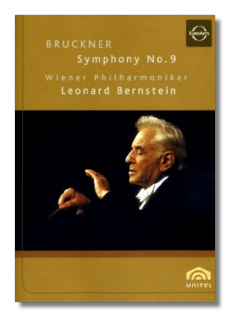
The Internet's Premier Classical Music Source
Related Links
-
Brahms Reviews
Bruckner Reviews - Latest Reviews
- More Reviews
-
By Composer
-
Collections
DVD & Blu-ray
Books
Concert Reviews
Articles/Interviews
Software
Audio
Search Amazon
Recommended Links
Site News
 DVD Review
DVD Review
Symphonies on DVD

Johannes Brahms
- Symphony #1 in C minor, Op. 68
- Symphony #3 in F, Op. 90
Israel Philharmonic Orchestra/Leonard Bernstein
EuroArts DVD 2072048 94min LPCM Stereo DTS Dolby Digital Full Screen


Anton Bruckner
- Symphony #9 in D minor
Vienna Philharmonic Orchestra/Leonard Bernstein
EuroArts DVD 2072018 74min LPCM Stereo DTS Dolby Digital Full Screen
The recording dates for Bernstein's Brahms are identified as "1-3 August 1973," so it is unclear whether or not they are composite performances made over the course of two or three days. I suspect that they are, because the same audience members seem to be wearing the same clothes in both symphonies, and Bernstein's podium has a rug draped over it in some shots – to muffle the impact of his athletic conducting style? – but not in others.
Bernstein recorded Brahms' four symphonies with the New York Philharmonic, and again with the Vienna Philharmonic (live) in the 1980s. EuroArts's booklet writer David Gutman unkindly uses the present performance of the Third Symphony as a cudgel with which to beat the later one from Vienna, which he calls "a rather self-indulgent dawdle." Even in 1973, Bernstein's Brahms was hardly a model of lean and flowing objectivity. The last movement of the First Symphony requires 18:13 here, and the first movement of the Third requires 14:19. (Granted, Bernstein observes repeat signs.) Even when tempos are not objectively slow, they feel that way, given the thickness and the weight of the Israel Philharmonic's sound. The interpretations are portentous and swoony. The one word that came to my mind in connection with these performances was "obvious," in the sense that Bernstein crashes through doors that already are open. It drives the audience wild, but it's neither insightful nor subtle. Interestingly, the movement one expects Bernstein to feast upon – the Poco Allegretto from the Third – is played almost briskly here (5:47), and without exaggerated expression. I suspect this is because Bernstein "dawdles" over the second movement so much that it is artistically unfeasible not to conduct the third with significantly more animation. If I am giving the impression that I dislike these performances, that is not true. There's a place in my universe for big-band, big-boned Brahms played with more splendor than subtlety, and plenty of moans and groans. It's just that I wouldn't want to live with these performances exclusively. Also, the Israeli players (particularly the brass) are not quite on the same level as their counterparts in New York and Vienna.
The stereo sound-stage is not wide, and the sound is not ideally balanced, but it still has a lot of oomph. Humphrey Burton's direction is unfussy, and it gives both the members of the orchestra and Bernstein equal time. The images, originally shot to 35mm, are still crisp and clear. The screen format is 4:3.
It is easier and safer to recommend the Bruckner DVD. Again, Bernstein made commercial recordings of Bruckner's Ninth in New York (for Sony) and in Vienna (for Deutsche Grammophon). The latter performance has received much acclaim, and the present DVD is a contemporary that audio-only recording. At this point in his life, Bernstein was in precarious health, and it is not unreasonable to suggest that he must have taken this symphony – one of the classical repertoire's most devastating confrontations with mortality – quite personally. The conductor's characteristic charisma still is present, but it has been put to the service of Bruckner's music without equivocation, particularly in the second and third movements. The second movement is played slowly (12:33) and Bernstein thereby emphasizes its cruel implacability. The third movement (29:00) alternates between nostalgia and anger, and as the movement draws to a close – after Bruckner's shocking climax – one feels that Bernstein is not offering eternal rest on behalf of the composer, but instead something equally final but less comforting. The Vienna Philharmonic plays gorgeously throughout. Again, given the recording dates (February 29 – March 2, 1990), one assumes that minor performance faults were edited out and corrected.
Humphrey Burton is the director here as well, and his work is similarly self-effacing and balanced. Minor artifacts reveal that the source is film, not tape. Otherwise, the image (4:3) is good – I am a little surprised it is not better – and the sound is excellent. The DVD had tracking difficulties on one of my players, but it was fine on the other one.
Copyright © 2007, Raymond Tuttle




















